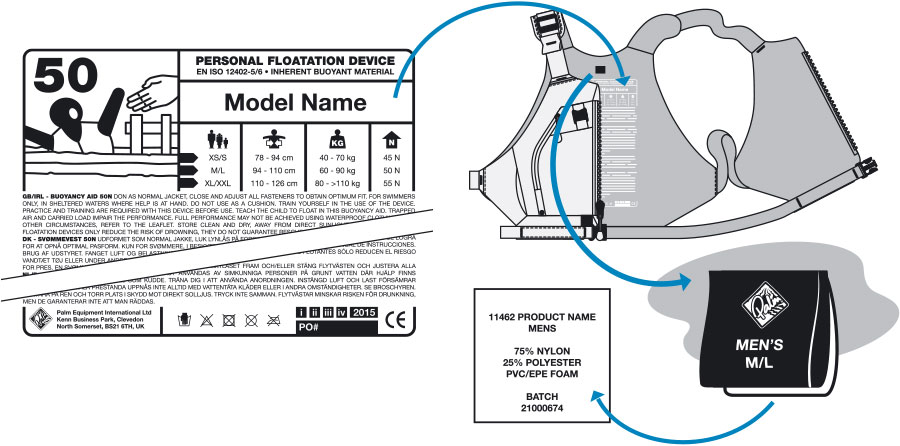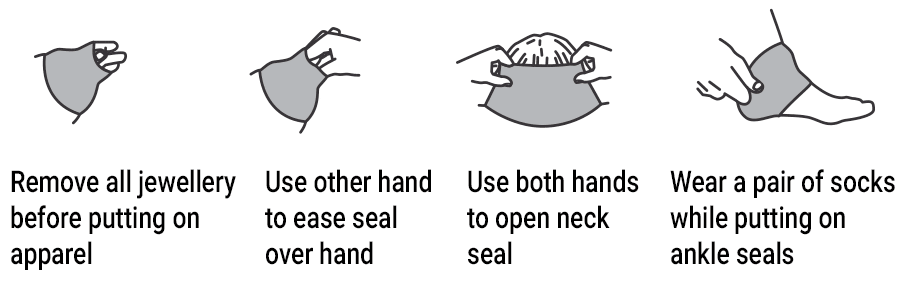All gear weathers and wears with use. You'll find advice in this section on the things you can do to maintain your gear, to keep it working for you. It's simple to perform most checks every time you use your equipment, and take steps to maintain your gear each time you hang it to dry or put it away. Other checks (like float testing your PFD) or maintenance (like restoring the DWR on your jacket) need only to be done periodically or when you suspect a loss of performance.
We make PFDs that exceed ISO standard for buoyancy and integral strength. Our CORDURA® fabric shell PFDs are particularly tough. Look after yours and it will look after you.
PFD maintenance guide download
Washing – rinse PFDs in clean, fresh water after each use to help reduce corrosion or degradation of materials.
Drying – drip dry PFDs out of sunlight. Frequent forced drying in drying rooms will shorten the lifespan of the material and foam.
Storage – hang PFDs on hangers from the shoulder straps. Avoid storing them wet or damp. Avoid stacking or boxing your PFDs for long periods – sustained compression will damage the foam.
A visual check as you pick the PFD from the rail and fit it should be part of every session. Periodically float test it: for light or medium users, we recommend that you should float test your PFDs every year from 3 years after date of purchase; for heavy users we recommend beginning annual float testing after 2 years. If a product does not pass any of these checks below it should be sent to Palm for repair or retired. If you find a fault, remove your PFD from use and decide whether to retire or repair it. Call our customer service team for advice or to arrange a repair at a reasonable cost. For warranty claims return your PFD to us for assessment as soon as possible. We advise that you do not perform repairs yourself.
Maximum lifespan – Palm PFDs must be retired 10 years after purchase, regardless of condition (see lifespan policy for details).
| No use | Light use | Medium use | Heavy use | Intense use |
|---|---|---|---|---|
| Left unused and stored. | Used irregularly (16 hours/month) | Used regularly (8 hours/week) | Used regularly (2 hours/day) | Used constantly (3+ hours/day) |
| 10 years | 5 years+ | 3-5 years | 2-3 years | 1-2 years |
Palm PFDs are labelled with their size, batch number and rated floatation (old products may be labelled differently). The size is marked on the fabric label inside the back of the PFD and the label beneath shows the product’s name and code, principle component materials and the batch number.
Printed in the back of your PFD is the ISO label, showing the ISO standard to which it is rated, the rated floatation for that size and model of PFD and a guide to fit for paddler size and weight.

Palm PFDs are made to ISO 12402-5 (level 50 standard) and 12402-6 (special purposes standard), many Palm PFDs exceed this standard. This standard covers a range of weights with 50 N buoyancy for an adult of 70 kg or more. For small people and kid’s PFDs this scale applies:
| Wearer’s weight (kg) | 30-40 | 40-50 | 50-60 | 60-70 | >70 |
|---|---|---|---|---|---|
| Minimum buoyancy (N) | 35 | 40 | 40 | 45 | 50 |
To test your own PFDs you will need: a hanging scale (electronic luggage scales are good), a short length of rope, a 10 kg weight (12 kg if you’re testing a model with more than 100 N floatation like the Highside Rafter), and enough fresh water to dunk your PFD and weight entirely underwater (a swimming pool or large barrel are ideal).

All helmet plastic degrades with time and use: glue, webbing, buckles and cradles will all be subject to wear and tear. How long your helmet lasts will be affected by how often they are used, the environment in which they are used, and how well they are maintained.
Helmet maintenance guide download
Washing – rinse helmets in clean, fresh water after each use to help reduce odour, corrosion or degradation of materials. The liner in a Shuck helmet can be removed and machine washed on a 30 °C cycle.
Drying – drip dry helmets out of sunlight and away from heat sources. Frequent forced drying in drying rooms will shorten the lifespan of the foam inserts and parts.
Storage – store helmets upright on a shelf out of sunlight. Do not hang helmets from the chin strap. Do not store helmets wet or damp. Avoid stacking your helmets, as sustained compression can damage the shell.
Do not use permanent marker, paint or self adhesive stickers to add identifying marks to your helmet. Popular sticky mounts, for cameras and lights, may affect the shell material, attach them at your own risk, their effect on the helmet is not covered by warranty.
Make a visual check each time you fit your helmet. We recommend that you should carry out these checks. If a product does not pass any of these it should be repaired by Palm or retired.
Should the shell sustain significant impact, for example resulting in deep abrasion or gouges, then the helmet should be retired from use.
Repeated low level impacts, such as being dropped onto hard surfaces, can result in damage in the form of white marks on the inside of the shell. Tests show these would be unlikely to result in the shell not performing to the ISO standard, but you should consider the age, amount of use and extent of any damage when deciding to keep using your helmet.
Significant bleaching of colour of the shell, through exposure to UV in sunlight, is an indicator that the plastic material may be degraded and the helmet should be retired from use.
AP helmet shells are injection moulded using polypropylene impact copolymer. This plastic has an ultra high impact resistance significantly exceeding the 15 kJ required by the ISO/EN 1385 standard.
Repeated low level impacts, such as being dropped onto hard surfaces, can result in damage in the form of white marks on the inside of the shell. Tests show these would be unlikely to result in the shell not performing to the ISO standard, however we advise that you consider the age, amount of use and extent of any damage as to whether to keep helmets in service. Should the shell sustain significant impact, for example deep abrasion gouges, then the helmet should be retired from use.
Maximum lifespan – Palm AP2000 and AP4000 helmets have a maximum lifespan of 10 years – Palm Shuck helmets have a maximum lifespan of 5 years from date of purchase (see lifespan policy for details) – after which they must be retired regardless of condition. However your helmets condition and lifespan will vary depending on the volume of use it incurs.
All helmets degrade with time – webbing, buckles and shell material are subject to wear and tear, the effects of UV or from impacts. How long your helmet lasts will be affected by how often they are used, the environment in which they are used, and how well they are maintained.
| No use | Light use | Medium use | Heavy use | Intense use |
|---|---|---|---|---|
| Left unused and stored. | Used irregularly (16 hours/month) | Used regularly (8 hours/week) | Used regularly (2 hours/day) | Used constantly (3+ hours/day) |
| 10 years | 5 years+ | 3-5 years | 2-3 years | 1-2 years |
The bag, closure, rope and knot are all important for a successful rescue, but a throwline that misses the mark, gets tied in knots or stays at home is of no use. Practice with your line and carry it with you. Be familiar with the parts of your throwline and keep it in good condition.
Throwline maintenance guide download
Washing – rinse your throwline in fresh water to remove mud or grit.
Drying – drip dry your throwline with the rope in loose coils, out of the bag.
Storage – store your throwline in a dry place, either hung in coils or packed dry in the bag.
Before you use your throwbag for the first time, unpack, re-pack and test throw it. Make a visual check each time you use or repack your throwline. We recommend that you should carry out the checks below. If a product does not pass any of these it should be repaired or retired.
Ropes and moving water can be a dangerous mix, as they sometimes get snagged or tangled during the course of a rescue. There should be no knot or loop at the end of the rope furthest from the bag to ensure that the rope is releasable. We've eliminated all unnecessary knots or loops in the throwbag rope and kept any loops too small for a hand or wrist to fit through. Palm throwbags have a Quickclip attachment point which can be detached from the rope if required and is very easy to clip a karabiner to.
Please bear in mind that tying knots in the rope will reduce its strength and can lower the breaking load by as much as half.
The rope inside our bags is fastened to the Quickclip webbing with a rethreaded figure of eight, so you can remove and reattach the bag whenever you need to. It's a good idea to periodically check that the rope is well knotted into the bag with a well dressed knot and an adequate tail.
Our XP fabrics are highly waterproof, breathable and durable. Our garments are made for life on the river or at sea. Nevertheless you can keep your garment waterproof and breathable for longer if you follow a few simple steps:
Look after your neck, wrist and ankle seals, if you want to keep the water on the outside! Latex seals are not 100% watertight. Movement will always cause a minor amount of seepage, but this is usually insignificant and should not affect your comfort. Due to their vulnerability, no guarantee can be given on latex seals once the garment has been worn.

The size of the latex seals are related to the size of the garment. Should a seal feel excessively tight it is possible to achieve a custom fit by carefully trimming the seal with sharp scissors – neck seals have concentric rings as a guide. Take care not to trim too much – ideally, you should wear the garment outdoors in cold weather to assess the size required before deciding whether to trim your seals.

Most of our trousers and suits have breathable waterproof socks with taped seams and reinforced soles or they have latex socks.
Don’t walk around or paddle in your socks without overshoes. Both fabric and latex socks can be damaged by sharp or abrasive things like grit, sand or toenails. It’s best to wear a comfortable layer inside your waterproof sock, try the Tsangpo fleece socks.
We can replace worn out socks at Palm through our repair service. Socks may also be fitted to garments that originally had latex or neoprene gaskets attached by our UK customer services department.
Palm use the best waterproof zips in our pants and suits. Take care of your zip to ensure that the teeth stay aligned and the zip functions smoothly.